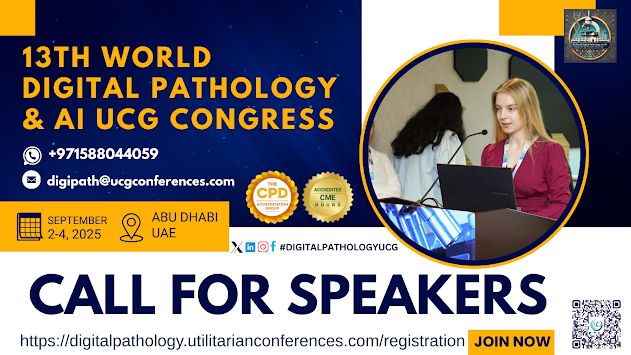From Microscope to Machine Learning: The Future of Diagnostics at UCG 2025
As the world of healthcare continues to evolve, the
field of diagnostics stands on the precipice of a ground breaking
transformation. From the traditional use of microscopes to the cutting-edge
advancements in machine learning and artificial intelligence (AI), the future
of diagnostics is being shaped by technology. The 13th World Digital Pathology
& AI UCG Congress, set to take place in Abu Dhabi, UAE, from September 2-4,
2025, promises to showcase the latest innovations and explore how these
technologies are revolutionizing diagnostic practices worldwide. For more
information, visit UCG 2025.
The Rise of Digital Pathology: A New Era of
Precision
For centuries, microscopes have been the
cornerstone of medical diagnostics, enabling pathologists to examine tissue
samples and identify diseases like cancer. However, this method, while highly
effective, is time-consuming and subject to human error. The introduction of
digital pathology is set to change the game by enabling the digitization of
tissue samples, allowing for more accurate, faster, and scalable diagnoses.
Digital pathology involves the use of high-resolution
scanners to capture detailed images of tissue slides. These images can then be analysed
using sophisticated AI algorithms to detect abnormalities and patterns that may
otherwise go unnoticed. This shift not only enhances the accuracy of
diagnostics but also improves workflow efficiency, helping pathologists provide
quicker results to patients.
At the UCG 2025 Congress, one of the major tracks
will delve into Digital
Pathology Image Analysis, focusing on how AI is helping
automate and augment traditional diagnostic practices. With AI-powered tools,
pathologists are able to make more informed decisions, drastically reducing the
risk of errors and enabling earlier detection of diseases.
Machine Learning: Unveiling Patterns in Data
Machine learning (ML) has already made a
significant impact on a wide range of industries, and healthcare is no
exception. In diagnostics, ML algorithms can be trained to recognize complex
patterns in medical images, clinical data, and genetic information. This
ability to process vast amounts of data quickly and accurately is particularly
valuable in fields like oncology, where early detection and precise treatment
are crucial.
For instance, ML models can be used to analyse
radiology images, pathology slides, and even genetic sequences to identify
subtle patterns that may indicate the presence of cancer, neurological
disorders, or other conditions. These models learn from large datasets,
continually improving their accuracy as they are exposed to more data, thus
enabling more precise and personalized treatment plans.
At UCG 2025, experts will explore AI and Machine Learning in
Diagnostics, discussing how these technologies are enhancing
diagnostic precision and driving the shift towards personalized medicine.
Machine learning algorithms are not only capable of identifying patterns but
can also predict disease progression and patient outcomes, allowing healthcare
providers to tailor treatment plans based on individual patient data.
Telepathology and Remote Diagnostics:
Breaking Down Barriers
One of the most exciting developments in digital
pathology is telepathology,
which allows pathologists to analysed digital images remotely, overcoming
geographical and logistical barriers. This technology has the potential to
revolutionize diagnostics, particularly in underserved regions where access to
specialized healthcare professionals may be limited.
Telepathology allows pathologists to collaborate
and share insights in real-time, providing patients with access to expert
opinions regardless of their location. The integration of telemedicine and
AI-driven tools means that patients in remote areas can receive accurate
diagnoses and timely treatment recommendations without having to travel long
distances.
At UCG 2025, discussions around Telepathology
will focus on the role of AI in enhancing remote diagnostic capabilities and
how this technology can be further integrated into healthcare systems globally.
With the help of AI-powered tools, telepathology can ensure that remote areas
benefit from the same high-quality diagnostic services as urban centers.
The Future of Diagnostics: A Harmonious
Integration of Technology and Human Expertise
While the advancements in digital pathology, AI,
and machine learning are exciting, it’s important to remember that these
technologies are meant to complement, not replace, human expertise.
Pathologists and clinicians will continue to play a vital role in interpreting
results and making final diagnostic decisions. The future of diagnostics lies
in the harmonious integration of human expertise with cutting-edge technology.
At UCG 2025, the conversation will center on the synergy between AI and
human professionals—how digital tools can enhance the work of
pathologists and clinicians, making them more efficient and accurate in their
diagnoses. The Congress will explore the potential challenges of implementing
these technologies, including ethical considerations, data privacy, and the
need for continued professional training.
Conclusion: The Road Ahead
As we look ahead to UCG 2025, it’s clear that the
future of diagnostics is bright, driven by innovations in digital pathology,
AI, and machine learning. These technologies are set to reshape the way we
approach medical diagnostics, providing faster, more accurate, and more personalized
care. The 13th World Digital Pathology & AI UCG Congress will be a pivotal
moment in this ongoing transformation, bringing together thought leaders,
researchers, and healthcare professionals to explore the full potential of
these game-changing innovations.
The road ahead is paved with possibilities, and
the future of diagnostics is already here—combining the power of microscopes
with the precision of machine learning to unlock a new era of healthcare.




Comments
Post a Comment